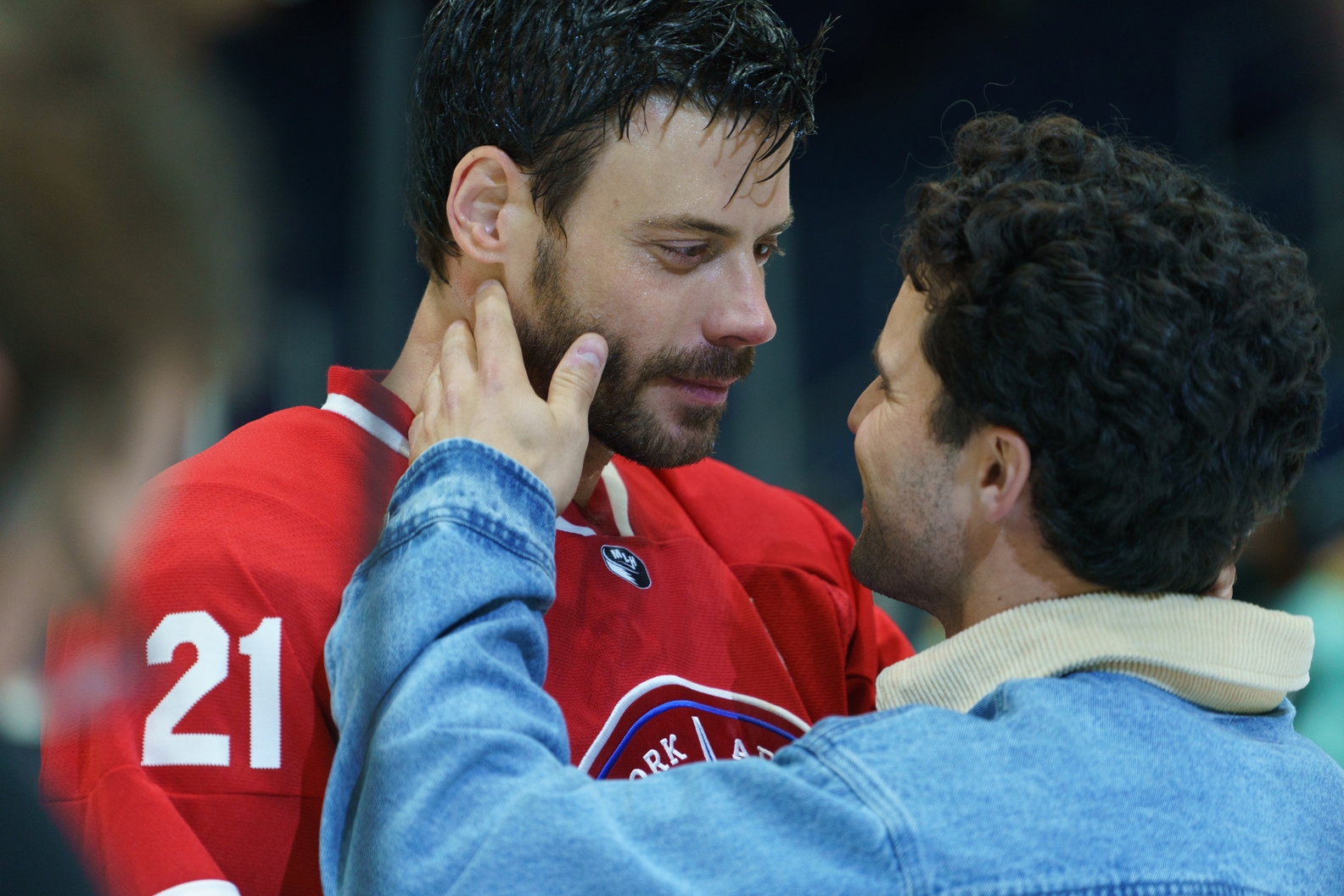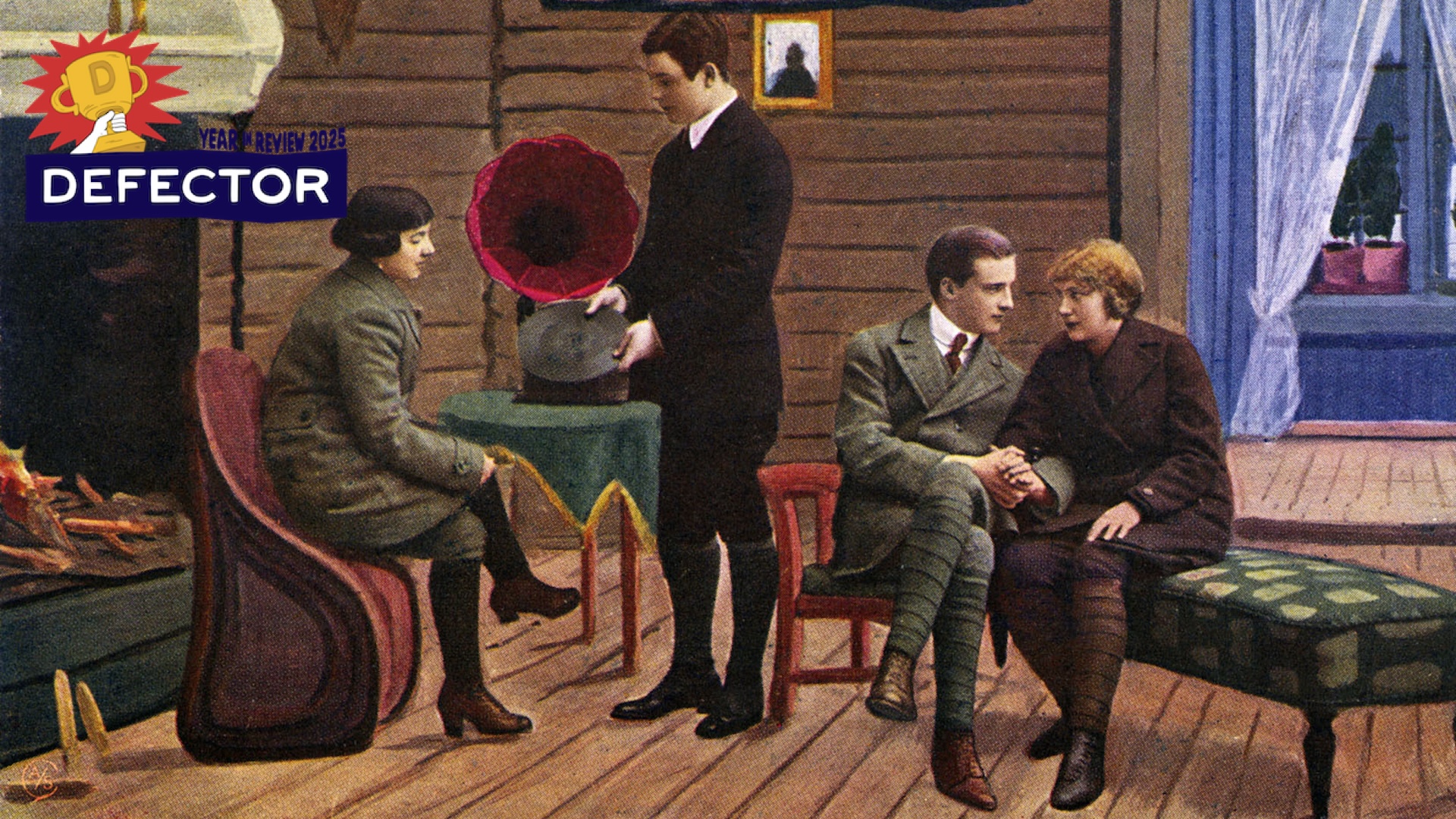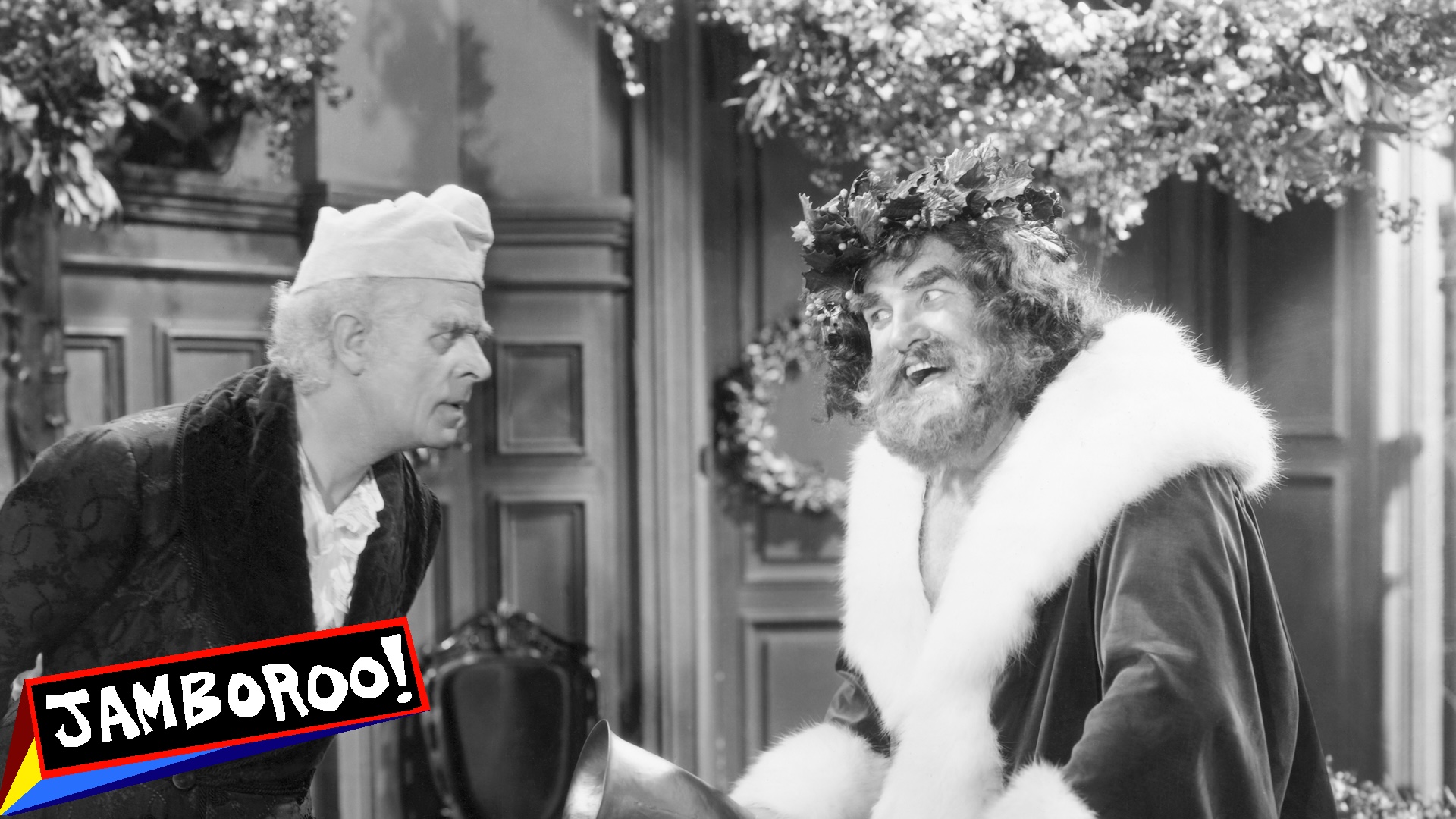Mönch (Monk) is a solid polyester figure, life-sized and jarringly lifelike in its details, depicting a somewhat gaunt man dressed in roughly Franciscan habit: a floor-length cowled robe, a rope cintura with three knots around his midsection. He hunches ever so slightly forward but otherwise is just standing, with his arms loose at his sides. His eyes are closed. From head to toe, he is a perfect matte black; he drinks the light and returns virtually none of it.
In a circuit of the Glenstone Museum's Iconoclasts exhibit, Mönch, by the German artist Katharina Fritsch, comes a short walk after a visitor passes Bruce Nauman's Good Boy Bad Boy, an entire wall of short English phrases (e.g. I AM ALIVE / YOU ARE ALIVE / WE ARE ALIVE / THIS IS YOUR LIFE) in blinking neon lights arrayed in a wild variety of colors. The effect of encountering Mönch's pure, uncanny blackness afterward—round a few corners and there stands a virtual silhouette, a yawning man-shaped hole in the space of a well-lit room—is immediately unsettling. My eye wanted to look and not look, darting to Mönch and then careening away as though bouncing off him, the way light apparently does not, maybe in sheer bewilderment at his uncanniness or maybe for fear of being drawn in. The longer I stood there, the more Mönch rooted into my mind and imagination as though searching through a dusty old toy-chest, pulling odd things out and tossing them around.
Things like: In Wounds, a collection of short, linked horror stories by weird-fiction author Nathan Ballingrud, characters encounter mute and apparently blinded monks of the Order of the Black Iron, a Satanic monastic order occupying the border areas of physical, geographical Hell, who act as both Hell's cartographers and its living maps; in their perfect, total stoicism, the reader is stranded to imagine the indescribable obscenities to which they have borne witness. There's a tension, an expectancy, in Mönch's eyes being closed. He is standing, lifelike, not asleep, and so his eyes could, at any moment, fly open, and so standing in front of him, I could not help but imagine that maybe they would.
And: In the very frightening short story "The Man in the Black Suit," by Stephen King, a child fishing by a creek in the woods dozes off, and when he awakes has been joined by a tall, gaunt, sinister, black-suited man whose eyes are "the orangey-red of flames in a woodstove"—a man lit from the inside by fire, like a jack-o-lantern. What would (will) Mönch's eyes look like if (when) he opened (opens) them? Will they be a record of whatever turned him into charcoal?
And: A black hole is characterized by gravitational pull powerful enough to devour even light, which can reveal nothing about the black hole beyond the fact of its existence—a secrecy so total as to be annihilating, as to suggest a final boundary on the knowable universe, as to contain beyond its horizon the collapse of even the physical laws I take for granted. What does this charred mendicant think about?
I am an unsophisticated and somewhat insecure viewer of art, always suspecting that whatever a work makes me think about is probably dumber and several levels shallower than some other, better thing to think about. In this case, I'm fairly sure of it. Standing in front of Mönch on the sweltering final day of July 2025, I was not thinking abstractly about religion, or faith, or the committed self-denial implied by monastic garb, or what Mönch's blackness and closed eyes might be taken to suggest or symbolize about any of that; I was thinking about genre-fiction stories about spooky Hell-monks and scary guys in the woods who try to eat little kids. I was thinking, like, If the power went out right now, I would die immediately and Honestly, I kind of hope that happens? and Why am I like this.
Over this past weekend, I saw some screenshots where somebody was arguing—asserting, really—that in the future most art will be made with generative AI, and therefore that to reject AI-created artworks was to consign oneself to a future deprived of art. I regard this as preposterous on its face. The claim that people will ever largely stop making their own art seems as obviously wrong to me as the suggestion some other tech guy made a while back to the effect that chatbot summaries would soon obviate book reading; these are things people have done for absolutely as long as it has been possible for them to be done, and the creation of art in particular I regard as a defining feature of the human race. I posted something about AI art not being art at all, and about what I view as the importance of maintaining that distinction, and moved on with my day.
But then, and maybe tediously, and I apologize if your response to the following is a deep groan of dismay, but: What is art? There are whole libraries' worth of books addressing this question, all of them wiser and more authoritative on the subject than I could ever hope to be, but also this is my blog and this is what Mönch and that dumb thread did when they came together and fermented inside of my head.
Fritsch makes a decent and perhaps familiar locus for this question. Her work, which consists in large part of objects similar to Mönch, cast out of molds in a single color and then stood up somewhere, has been a frequent target of "NOT ART" criticism much like that directed at Marcel Duchamp's "readymade" works—like the infamous Fountain, an ordinary manufactured porcelain urinal turned on its side and signed "R. Mutt," also on display in Glenstone's Iconoclasts exhibit.
Duchamp—whose other readymades included stuff like Trap (Trébuchet), an ordinary coat rack stationed near the entryway of an art exhibit, which visitors failed to realize was art and not merely a coat rack—famously argued that the artist's intention, their "act of choice," was sufficient to transform any mundane object into art. Thus, he could prop up a bicycle wheel (Bicycle Wheel, recreated several different times in Duchamp's lifetime by literally propping up a bicycle wheel and calling it Bicycle Wheel), declare that it was art, and it would be art. Personally, I find this convincing, less for its iconoclasm or contrarianism, or for the coat rack being really funny and kind of ingenious, or for Dadaism's roots in social critiques to which I am deeply sympathetic, than for how it centers the human imagination, rather than any specific set of aesthetic values or artistic techniques, in the definition of art.
Thus, Duchamp inverting a urinal he found and calling it Fountain is art, because it represents the human endeavor to create art and the human mind's capacity to imagine new meanings for things; the Gemini AI generating a breathtaking religious scene on the scale of The Last Judgment is not art, because it's just some shit a machine spat out in response to a prompt. Louise Nevelson telling some brawny beefcake where to put a big chunk of wood is art, because both Louise Nevelson and the beefcake are humans with the intention to create art; DALL-E producing an expressionistic whorl of bold and turbulent color that draws gasps from everyone who views it is just a pretty image and not art, because it's just some shit a machine spat out in response to a prompt.
I suppose it's reasonable to ask, then, why a human's intention to make art couldn't transform into art some shit a machine spat out in response to a prompt. The short answer is "Shut up." The medium answer is "It can: Print out the AI-generated image on paper, fold it into a goose, call it Airplane, and it will be art if you intend for it to be art, wiseass." The longer answer has to do with the word "intelligence," which does not accurately describe the products doing business as generative AI, but which represents an engineer's intention to create a synthetic mind, a marketer's intention to convince you that what the engineer created is a mind, and a user's intention to employ the engineer's creation as a mind.
Nobody confuses a paintbrush for a mind that makes artistic choices, or deploys it as one. When an artist applies paint to a canvas with a paintbrush, they are not abdicating their human artistic agency to the brush, or meekly requesting from the brush, as though it were a genie, what would otherwise take them hours or weeks or months to create for themselves. Whether the resulting bowl of fruit looks good or looks like shit, the creativity and art are theirs. The paintbrush facilitated their human labors; it did not replace them.
Nobody confuses MS Paint for a thinking, decision-making consciousness, even at the crudest level, even though it is a software program. When Defector's Chris Thompson creates an image of a goldfinch with MS Paint for the newsletter, every pixel of the image represents an individual choice—a hue or shade carefully selected and placed, click by click—that he, and not MS Paint, made. If he does not make those choices, one by one, the image of the goldfinch simply will not exist. He could not simply request from MS Paint an image of a goldfinch; he couldn't abdicate his human act of choice to MS Paint even if he wanted to. But if he could, and did, then calling what he received from it "art" would be as absurd as calling the results of a Google keyword search "a novel."
Which gets at something else important, I think, and unfortunately for you unlocks a perhaps even longer and more exhausting answer. It has to do with where an AI-generated image comes from, and the process it reflects. Generative AIs are stocked ("trained," in the insulting anthropomorphic industry jargon) with the pilfered creative works of humankind, as essentially a reference library, on the basis of which the machine calculates what is, by the design and intent of its engineers, a convincingly correct output to any prompt. You input a prompt for an image of a river running beneath an arched stone bridge in the style of an 1875 French impressionist, and the program roots around inside its stolen hoard and outputs what its programming estimates is the most credible fulfillment of that prompt. Thus, at root, its algorithmic target is some combination of mimicry and marketing, to demonstrate that the AI does what its creators claim; by definition, every deviation it makes away from bare fulfillment of the prompt is a failure.
There's a sort of contradiction there that I find deeply annoying. So-called AI artists want credit for the machine's outputs, yet the closest thing to artistry you'll find in any AI output is wherever the machine mindlessly violated their prompt—where it was supposed to have portrayed a foxy human babe but gave her 13 nostrils and three buttcheeks, or was prompted to output a sweeping medieval high-fantasy vista but gave one of the brave knights a MAC-10 and a motorcycle. That is where, were the AI instead a human mind—or any kind of true mind at all—its inspiration and agency, its mystery, its expressiveness, its having anything to express in the first place, would be showing themselves. That is where art, and not just design or illustration, would be happening.
But the claim that generative AI is a tool that can help a human to make art requires that the AI have no inspiration, that it does nothing but fulfill the prompt given to it by its human operator—were it otherwise, the human operator would have no more justifiable a claim to credit for the resulting work than an art-class teacher does for the paintings her students produce when she instructs them to portray a certain model. The only way for the human operator to claim authorship of an AI-generated work is for that work to contain nothing indicative of genuine artistry's mystery and expressiveness. Otherwise, the human operator might just as credibly stand in the vestibule at 6:30 in the evening, request a sunset, then step outside and claim to have created one.
Maybe there are human brush-on-canvas artists who approach their work the way the AI is designed to: totally without any concept of self-expression, seeking only to get A+ grades in mimicry and in Being A Good Boy. Even then—even then!—their work expresses something about them, even if only that they are obsequious weasels or smarmy cynics, that an AI's output cannot reproduce. Because, as humans and not insensate algorithms operating on a database of stolen human artworks, they have contents to express.
I am thinking about Mönch. Specifically, I am thinking about standing in front of Mönch and feeling mystified by it: What is it? Why is it this and not any other thing?
Katharina Fritsch had this in her; I can know that, and I can wonder about it, but Mönch is not the introduction to the text explanation of Mönch. Rather it is, in and of itself, the communication from the world inside of her, and what it says is this matte black monk with his eyes closed, standing in the Glenstone Museum's Iconoclasts exhibit, making you think and feel whatever it makes you think and feel. That is the message. Polyester is the language. Mönch is a choice, a cluster of choices—ones that might be just as mystifying in their origins and intents to Fritsch as they are to me.
What makes that enigma, that bafflement, for anyone who experiences it, is Fritsch's humanity and their own. Mönch's unknowability, the tension of his closed eyes that hums in the room like some strange radiation, is that he came from another person; his light-swallowing blackness is the gulf between me and her, the choices she made that would never occur to me, the Why am I like this and the What am I like. To be mystified by a work of art, I think, is to encounter the world with dizzyingly renewed depth-perception, to have the realness and profound interior vastness of each other human being revealed like the view from an unfathomably high clifftop—to feel that vastness suddenly, the way a person in a boat all at once realizes that the ocean beneath them goes down, straight down, for miles, and then that the entire planet Earth is next to them in space, and maybe grips the gunwale a little more tightly, but also and more importantly experiences awe and wonder.
We make this possible for each other. All of whatever meaning art has, Les Saltimbanques or Mönch, the cave drawings at Lascaux, or a spiral notebook filled with some kid's efforts at drawing a perfectly symmetrical Batman symbol, comes from us—from us creating it, and us seeing it, and from us thinking and feeling about it and ourselves and each other. Imagine asking a machine to do any of that for you. What would be left, of you or anything, if you pinched your eyes so tightly shut?







